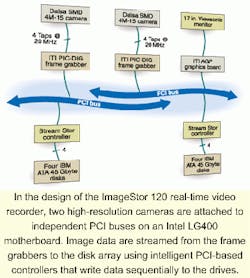Digital image recorder uses dual PCI-bus architecture
When asked by NASA's Wallops Flight Facility (Wallops Island, VA) to develop a stand-alone image-acquisition system, CJ Computational Systems (Louisville, CO) faced several system-bandwidth obstacles. Because the system was required to both capture and store high-resolution images at real-time rates, a single-slot PCI-based computer using traditional disk storage could not be used.
"Traditional computer storage systems, including those using redundant arrays of independent disks (RAID) and SCSI controllers, are designed to perform most effectively in applications that require optimization for random data accesses," says Carlos Jorquera, president of CJ Computational Systems. "And, although these storage systems can prove adequate for some real-time data-streaming applications, they are dependent on the host computer system and operating system."
To overcome this problem, Jorquera designed the ImageStor 120 using a dual PCI-bus motherboard from Intel (Sunnyvale, CA). In the system, image digitization is accomplished using two SMD-1M60 digital cameras from Dalsa (Waterloo, Ontario, Canada). Outputs from these cameras are output on four taps at a rate of 20 MHz per tap. Digital data from these cameras are transferred to the host computer using PIC-DIG frame grabbers from Coreco Imaging (Bedford, MA). Because the motherboard features two PCI buses, the system is capable of digitizing and storing two 1k x 1k x 12-bit images at rates to 60 frames/s.
To transfer data directly from the frame grabber to an array of eight 45-Gbyte drives from IBM Storage Technology Division (San Jose, CA), Jorquera used two PCI-based StreamStor boards from Boulder Instruments (Longmont, CO). In operation, an on-board PowerPC is used to manage the data-streaming process and provide an intelligent control interface to the host.
"Because the StreamStor PCI controller operates as a slave device when recording data, any data received by the controller is written sequentially to the disk system," says Jorquera. This direct card-to-card transfer eliminates operating system delays and provides optimum use of PCI bus bandwidth.
To support the system, CJ Computational Systems has developed a self-contained image-processing package that supports image-sequence capture and playback, frame averaging, subtraction, and flat-field and smear correction. Built-in support is also supplied for pixel statistics on any number of regions of interest, median filtering, and CCD defect correction.

